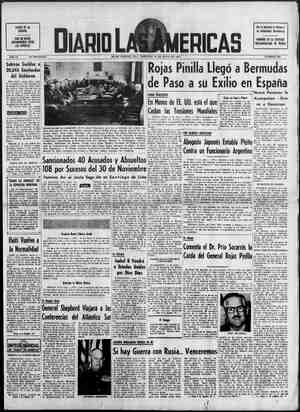Diario las Américas Newspaper, May 12, 1957, Page 26
You have reached the hourly page view limit. Unlock higher limit to our entire archive!
Subscribers enjoy higher page view limit, downloads, and exclusive features.
The Desolate Land Tierra del Fuego specializes in sheep and wide open spaces By JULIO C. SILVA MANY OF THE schoolbooks de- scribe Tierra de] Fuego simply as “the biggest sheep ranch in the world,” as if that were all there was to it. Its very immensity and desolation — 27,476 square miles occupied by ten thousand people — make the archipelago seem uni- formly monotonous. But within that uniformity and monotony lies a wild and inhospitable landscape with which not ‘even the wastes of Alaska or Siberia can compare. In fraternal fashion, the terri- tory is divided between Argentina and Chile. It is made up of six is- lands. The iargest, Isla Grande or Tierra del Fuego proper, is an ex- tension of Patagonia and of the Islands around Tierra del Fuege abound in penguins. makes braying souad, is called “jackass” Andean ridge, whose eternally snow-covered peaks, here as all along the line, mark the boundary between the two countries. The border runs from Cape Espiritu Santo on the Strait of Magellan to the Beagle Channel in the south. The lesser islands are labeled with an evocative mixture of names of various nationalities, chiefly Eng- lish. On the Chilean side there are Navarino, Hoste Island, Clarence Island, and Santa Inés. On the Ar- gentine side, in addition to its section of the main island, once ealled King Charles South Land, is Staten Island, a fact that might This variety Evergreen oaks are shaped by buffeting of prevailing winds. 8 raise some eyebrows around New York. What I remember best from a quick visit to, this remote region a few years ago is the look of its strange rocks, seemingly torn from a lunar landscape, combined with bare mountains, with torrential streams that suddenly dropped from sight in mysterous clefts, and the dark-gray, almost black, spattering of long-suffering coigue trees. (Notafogus enanus). With branches. twisted and tortured by wind and snow, they are the only arboreal vegetation. When Charles Darwin visited the zone, he noted, that it was an im- mense territory (one sixth of the area of Chile) whipped by hurri- canes and storms, a desolate land inhabited by cannibals and wild beasts, where the .most-horrible tragedies took place on land and sea. Life there was impossiblé for civilized beings. The English scho- lar emphatically declared that the plains were worthless. He called them “Cursed Lands” and said even the waters seemed to carry their curse. For a long time no country, not even Chile, wanted to assume the responsibility of officially taking possesion of the torbuous Tierra del Fuego. The Alacalufs, Onas, and Yaghans, the fierce nomadic Indian tribes who lived there, con- tinued to light the fires that had given the territory its name when Magellan’s sailors sighted them in 1520. Finally, in 1843, after four months of difficult navigation, the Chilean schooner Ancud, under Ca- ptain Juan Williams, arrived at Puerto de Hambre (named Port Famine by shipwrecked mariners). Atfer destroying documents left by -some Englishmen who had tried to take possession of the area at the beginning of the nineteenth cen- tury, Williams ordered the Chil- ean flag raised,-to the accompani- ment of the appropriate salvos. The next morning, September 24, a ._ French frigate under Captain Mais sain anehored at the~same place and raised the tricolor, amid ‘its own salvos. Likewise acting on or- ders of his government, the Frenchman had also come to take possession of Tierra del Fuego. Williams immediately protested the affront to Chilean sovereignty. The Frenchman, taking pride in his diplomacy, retired after an- nouncing that he would report what had happened to his govern- ment. To strengthen Chilean ties with this distant possession, President Franciseo Bulnes ordered a penal colony, now defunct, founded near the present site of Punta Arenas. Years later, in 1884, the Argentine Government did the same thing in its part of the territory, at Ushuaia. By a strange coincidence, halfway around the world ,something similar was taking place. New Bullocks are still used to haul heavy lads in high-wheeled carts on modern ranch. HEMISPHERE At the Argentine-Chilean border on Beagle Channel, a small police outpost keeps track of passing ships. ES Waterfront at Ushuaia. Many wrecks have occurred in rough Beagle Channel here. Snow-capped Andes overlook galvanized-iron houses of Ushuaia. Zealand and Australia, which also became some of the “biggest sheep ranches in the world,” were pop- pulated with criminals from Lon- xalue of these wastelands to the don jails. In 1857 there were thirty-four sheep on Tierra del Fuego ‘and the adjoining section of Chilean Pa- tagonia. Today there are more than seven million (one for each Chilean), producing more than twenty-one thousand tons of wool a year, of -which about eighteen thousand tons are exported. Argen- tina exports 130,000 tons, including what it grows on the mainland. The figures are eloquent proof of the value of these wastelands to the '. two nations. _ In addition to this wealth of wool, oil has been discovered in recent years in the Chilean spot known as Springhill which now has many wells. There is also pe- troleum across the Strait, near Punta Arenas, a town of forty- five thousand that is the world’s southernmost city. At first, the colonization of this area was a sort of Klondike gold rush. But Tierra del Fuego was much less accessible and offered far less gold. Some of the advent- urers of various nationalities drawn there turned to sheep rais- ing — because they had no alter- native, as the historians slyly ob- serve. The struggle for existence continued to be fierce. The Minis- try of Agriculture estimated that 75 per_cent of the first colonista (from 1850 to 1900) failed. The SUNDAY, MAY 12, 1957
